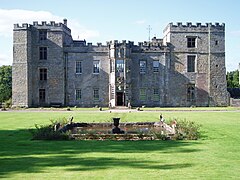Chillingham Castle
| Chillingham Castle | |
|---|---|

The castle in 2005
|
|
|
|
|
| OS grid reference | NU060257 |
| Coordinates | 55°31′34″N 1°54′18″W / 55.526°N 1.905°WCoordinates: 55°31′34″N 1°54′18″W / 55.526°N 1.905°W |
|
|
Chillingham Castle is a medieval castle in the village of Chillingham, Northumberland; in the northern part of Northumberland, England. It was the seat of the Grey and Bennet families from the 15th century until the 1980s when it became the home of Sir Humphry Wakefield Bt., who is married to a member of the original Grey family. A large enclosed park on the castle grounds is home to the Chillingham Cattle, a rare breed, consisting of about 90 head of cattle. The castle is a Grade I listed building.
The castle was originally a monastery in the late 12th century. In 1298, King Edward I stayed at the castle on his way to Scotland to battle a Scottish army led by William Wallace. A glazed window in a frame was specially installed for the king, a rarity in such buildings at the time. The Chillingham Wild Cattle occupy land adjacent to the castle, formerly owned by the Sir John Knott Trust, now owned by the Chillingham Wild Cattle Association (a charity not associated with the castle).
The castle occupied a strategically important location in medieval times: it was located on the border between two feuding nations. It was used as a staging post for English armies entering Scotland, but was also repeatedly attacked and besieged by Scottish armies and raiding parties heading south. The site contained a moat, and in some locations the fortifications were 12 feet (3.7 metres) thick.
The building underwent a harsh series of enhancements, and in 1344 a Licence to crenellate was issued by King Edward III to allow battlements to be built, effectively upgrading the stronghold to a fully fortified castle, of quadrangular form.
...
Wikipedia

